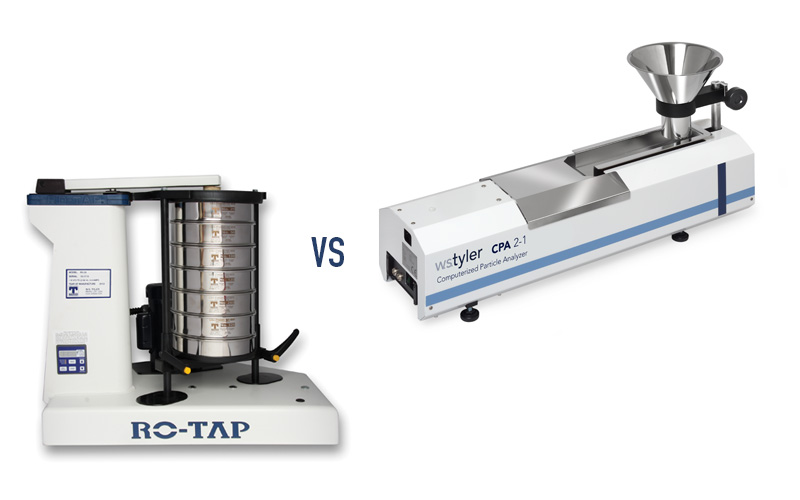What Is an Dynamic Image Analysis Alignment File? (Definition & Usage)
There are many avenues in which you can perform a successful particle size analysis and make the adjustments to your production line that count. Test sieve analysis has been a prominent method for decades.
Still, in recent years we have seen more innovative methods, such as Dynamic image analysis, have gained traction in the industry.
It is easy to have hesitations when researching these new methods, as you’re often unsure how much variation from your existing process should be expected. Fortunately, dynamic image analysis systems, such as the W.S. Tyler Computerized Particle Analyzer, feature alignment files that can help bridge this gap.
So, what is an alignment file? How do I integrate it into a dynamic image analysis?
W.S. Tyler’s main objective is to help lab managers and technicians develop a process that allows them to feel confident in the quality of their results and end product. This includes educating you and your staff on how to implement ancillary features, such as alignment files.
To ensure you fully understand how to leverage alignment files to create a cohesive dynamic image analysis, this article will cover:
- What an alignment file is
- How to create an alignment file
- How to properly use an alignment file
What Is an Alignment File?
All test sieves used for wet and dry sieve analysis have a tolerance. If the opening size of the sieve mesh is 1mm, generally particles sized at 1.1mm can pass through. On the other hand, dynamic image analysis systems, such as the W.S. Tyler Computerized Particle Analysis, will typically read a 1.1mm particle as a 1.1mm particle unless programmed to read them otherwise.

As a result, CPA results tend to reflect coarser material readings.
Alignment files essentially instruct the CPA to read particles with the exact tolerances seen in test sieves to better match dynamic image analysis results with test sieve analysis results.
How To Generate an Alignment File
To generate a reliable alignment file, you must first gather six various samples of your sample. For best results, some of the samples should fall on the coarser end of the spectrum and some on the finer end of the spectrum.
Now, run every sample on the CPA, generating a .han file for each sample. Next, run the samples on a sieve shaker and generate a .gan file.
At this point, you should start the .gl software, entering your six .han files and six .gan files in the upper left box. Once this is complete, save this .VGL file under the same file directory as your materials.
After the file is successfully saved, turn your attention to the right side of the box. Here you will find the following options: shape factor, factor manuell, table, and linear regression.
You can use these boxes to customize your correlations. If and after you make any changes to the correlation settings, be sure to save the correlation file making sure the file is saved within the .MTX file folder.
How To Use Your Alignment File
Once you have generated your alignment file, restart the CpaServ software to ensure the software can adequately retrieve and read the files you just made. After the software has reloaded, select the alignment file.
At this point, you can run the sample as you normally would. Once complete, go to the results list and cross-reference the results using one of the .gan files you created.
You should analyze the results list and identify how the .han file aligns with the .gan file. That said, they should overlap.
Moving forward, these alignment files will help run materiel through the CPA while maintaining the tolerances present when using a sieve shaker. The best of both worlds.
See How the CPA Can Benefit Your Operation First Hand
Alignment files are files that lab managers and technicians can use to instruct their computerized particle analyzer to analyze your material with the same tolerances you experience with a standard test sieve analysis. Using these files requires you to cross-reference the .han files and .gan files that you create when analyzing your results.
At this point, you should have a good idea of what the Computerized Particle Analyzer is and how it might fight into your lab setting. From here, you should reach out to our team of in-house experts and schedule to have a CPA demonstration for you and your staff.
Here at W.S. Tyler, we understand the uncertainty you have when browsing the market for new particle analysis equipment. The last thing we want to do is point you towards a solution that you’re not confident in.
This is why we always emphasize the importance of seeing and feeling how the CPA fits your lab first-hand. To learn how to request a CPA demo and what to expect during this process, read the following article and take the next step:
About Ronnie Brown
Ronnie is the Content Writer for W.S. Tyler and has four years of experience as a professional writer. He strives to expand his knowledge on all things particle analysis and woven wire mesh to leverage his exceptional writing and graphic design skills, creating a one-of-a-kind experience for customers.



